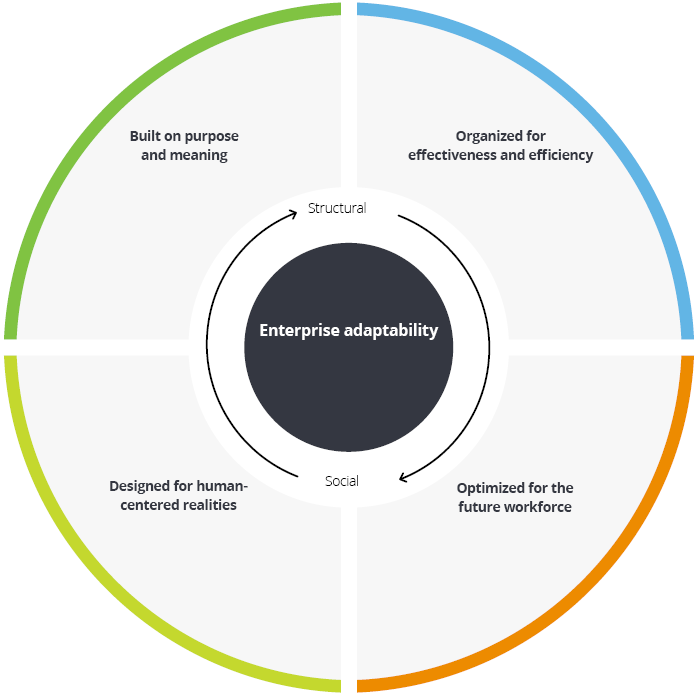Enterprise adaptability has been saved

Perspectives
Enterprise adaptability
Building the agile enterprise
How can you plan for the future and continually prepare your organization to expect the unexpected? By driving enterprise agility. Explore the four pillars of the agile and adaptive enterprise, as well as key questions that can help your organization move beyond quick fixes—and toward a complete reimagination of how to operate.
Designing an adaptive enterprise
Looking back on the past year, organizations had to pivot like never before. While maintaining business continuity and the physical and mental health of their employees, organizations had to adapt to an economy in crisis, new virtual ways of working, and rapidly changing consumer behaviors.
Now, with the gradual distribution of vaccines, organizations are increasingly planning for more changes. In the face of this unknown, organizations must be adaptable, with the ability to embrace change and rapidly respond to internal and external forces.
Before, an organization’s desire to become more agile and innovative was an indicator of success. Now, being an agile organization is an imperative for survival. So how exactly do you design for agility and adaptability? First, recognize that an organization is both a technical construct that needs to be engineered for efficiency and a social construct that needs to be nurtured to empower its workforce, customers, and communities.
Four pillars of an adaptive enterprise
Built on purpose and meaning
• Align around missions and outcomes
• Balance efficiency with adaptability
• Design for more than profit
Organized for effectiveness and efficiency
• Unravel complexity
• Sustainably reduce cost
• Simplify the corporate center
Optimized for the future workforce
• Harness the ecosystem
• Build Org. sensing & learning
• Govern the on/off-balance sheet workforce
Read more about enterprise adaptability and designing organizations around our best impulses.
Case study: Simplifying org structure to reduce time to market
A private, not-for-profit clinical research center was burdened by a complex and bureaucratic organizational structure. An assessment uncovered an abundance of shadow organizations, undefined roles, and inconsistent leadership responsibilities. The research center began with defining a purpose and refreshed operating model that intentionally centralized its functions around defined capabilities for each team, eliminating shadow organizations. Through reducing unnecessary layers of decision making and driving role clarity, the simplified organization structure reduced time to market by 50% and reduced costs while introducing employees to a more productive, straightforward way of working.
The path to enterprise adaptability
The COVID-19 pandemic forced organizations to rise to unprecedented challenges that required fast decisions and an empowered workforce to survive. Now, these organizations can carry these changes into the next chapter of their journeys.
While the four pillars of enterprise adaptability paint a picture of “what good looks like,” it’s up to organizations themselves to move beyond individual quick fixes toward a complete reimagination of how they operate. Leaders can start by asking themselves the following questions:
- Ecosystem: Are your decisions guided by an “outside-in” view that drives success beyond the metaphorical walls of the organization? Do you start your thought process with “What will our customers, partners, and suppliers say?”
- Organization: Are you ready to make significant changes to how you are structured and move from what’s comfortable and familiar (e.g., functional, matrix control) to what’s needed in a hypercompetitive environment?
- Leadership: Are you prepared to both invest in your current leaders to learn new skills and to also make difficult choices to bring new blood into the organization?
- Teams: Are you prepared to fundamentally change ways of working, governance, and daily routines to complement the choices you’ve made around how you lead and organize, including leveraging technology to implement superteams?
- Individuals: Are you ready to invest the time necessary to rethink traditional practices around how performance is managed, how succession is planned for, and how people are rewarded to bring your vision to life?
The need to be adaptable in these challenging times is self-evident, but the path to get there requires continued investment and organizational persistence. On the other side of this effort, though, is a workplace that has unleashed the full potential of its people by bringing more meaning, impact, and—dare we say—fun back to work.



